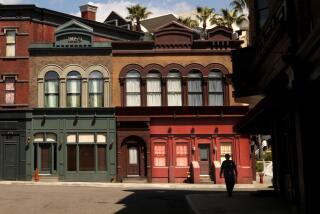White House Creates a New Home for Camera Crews
- Share via
WASHINGTON — It was the only blemish on the otherwise perfectly manicured White House lawn -- a slew of mud-splattered camera tripods, light riggings and umbrellas that marred the famous, leafy Pennsylvania Avenue vista.
Now, after a two-month, labor-intensive project, the North Lawn has a new look.
Gone is the gravel that gave the area its unofficial moniker “Pebble Beach” and marked a spot off the driveway near the West Wing where television reporters recorded their stand-up shots. In its place is a smooth, gleaming stone surface surrounded by trimmed shrubbery, shiny power outlets and drainage grates -- the new home for the more than 20 networks that broadcast from the White House.
“I didn’t think we needed it before, and now I love it,” said David Scherer, a CNN cameraman, hopping over cables and cords as he and other crew members set up equipment brought over from the East Lawn, where crews were moved during the renovation. “Instead of rectangles, they did all these lovely cuts,” he said, gesturing to the path pieced together with different-sized slices of stone.
Constructing a more orderly environment for television crews was a long time coming, said Peter Doherty, a senior producer at ABC who was the project liaison between the administration and the media.
“There has been talk for years [of creating a permanent space] once we moved [to the White House] and it become obvious we wanted to stay,” Doherty said. “This particular administration got focused on it and decided to get it done.”
Beginning in the 1970s, television crews worked on one side of the driveway near the main section of the lawn. The crews switched to the other side in the mid-1990s, after creating what amounted to a landscaping disaster, with packs of crews tearing up the lawn, creating a hole and turning the area into a muddy mess, said Gary Walters, chief White House usher.
There was “nothing permanent over there. It was haphazard,” he said.
In addition to the dirt and mud churned underfoot by reporters and camera crews, the networks wrestled with poor drainage and unreliable and unsafe power sources, officials said.
The crews were asked to move temporarily to the other side of the driveway to an area covered with pebbles while a solution was figured out.
“It was supposed to be for just a few years, and it ended up being seven or eight,” Walters said.
The exterior of the White House undergoes regular periods of dressing-up. The outside walls of the West Wing are being restored now, said Ashley Snee, a White House spokeswoman. The East Wing and portions of the residence also have been repaired. In the spirit of many home-improvement projects, enhancements and adjustments to the TV area came in stages, beginning with a permanent wiring system installed in 2000.
The complete overhaul of “Pebble Beach” was scheduled for August, during President Bush’s vacation at his Texas ranch, Doherty said. The National Park Service, which maintains the White House grounds, oversaw and paid for the project.
Complaints about the disorganized look of the television crews originated from the Bush administration and were a factor behind the renovation, Scherer said.
“We heard that it was unappealing to dignitaries when they came to the West Wing,” Scherer said.
The new area, just under the size of a tennis court, is fitted with Pennsylvania fieldstone, which is similar to the stone used in a patio off the Rose Garden. Power is generated from a single source and much of the wiring is buried, eliminating a labyrinth of cables. A low hedge runs along the perimeter, and stone walls housing the power and signal outlets line the back of the space, camouflaging some of the equipment.
Each network inhabits a 20-by-7-foot slab of stone. Markers that chalk out each network’s spot are intended to keep crews from spreading -- a common occurrence during the “Pebble Beach” era, when no official boundaries were set.
There also are rules to encourage the crews to behave in a way that matches the immaculate appearance of the new space, Doherty said. Crew members have been instructed not to eat or drink while on site. Although the administration hasn’t issued a similar decree, Walters said he hopes the area’s look can be preserved.
“I don’t think there’s been an official determination of what’s appropriate or inappropriate. I would hope that there is some pride,” he said.
With the work complete, the remaining order of business is to adopt a new name, Doherty said. A list has been posted with suggestions, including “Stonehenge,” “The Piazza,” and the somewhat blunter “The Slab.”
“ ‘Pebble Beach’ got official status because they started calling it that in the [television] show ‘The West Wing,’ ” Doherty said. “We’ll have to come up with something, now that there’s no more pebbles.”
More to Read
Get the L.A. Times Politics newsletter
Deeply reported insights into legislation, politics and policy from Sacramento, Washington and beyond. In your inbox twice per week.
You may occasionally receive promotional content from the Los Angeles Times.










